Now, Where Is Your Recession?
Summary
- The stock market is still holding up well although we declined more than 10% in the last few weeks.
- We are still waiting for the Fed pivot and increasing initial claims for unemployment as next "steps" towards a recession.
- However, we are already seeing increased bankruptcies and increasing delinquencies rates - especially for car loans.
- The stock market seems to be at a "make or break moment" right now - facing the risk of a steep decline in the coming months.
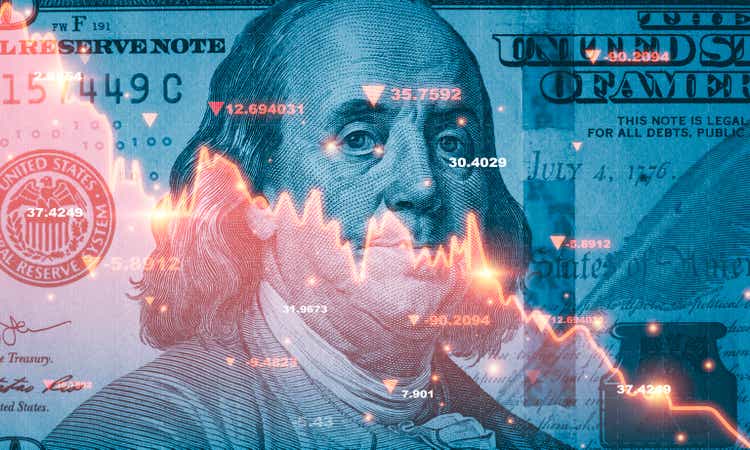
Dilok Klaisataporn
Aside from covering individual companies that qualify as long-term investments, I also look at the U.S. stock market (and economy) from time to time. And although the article was titled U.S. Stock Market: Staring Into The Abyss? I wrote:
In my opinion it is possible to see an increase to 4,300 in the coming weeks or months. But I honestly have extreme difficulties to imagine the S&P 500 increasing much higher.
The S&P 500 actually went higher. The index reached 4,600 points before the market turned again and we declined already 500 points so far. I am often mentioning that the stock market could increase again for several months, but the long-term view is bearish and I assume a multi-year bear market. But at some point, the recession and bear market has to happen – otherwise it is raising questions about my overall thesis.
Where Is Your Recession?
I have been talking about the recession for quite some time – although I didn’t check when I first mentioned the risk of a recession again, it was certainly more than a year ago. And while it is always difficult to predict if and when a recession will happen, the yield curve inversion (defined as the 3-months treasury yield being higher than the 10-year treasury yield) seems to be one of the best early warning indicators.
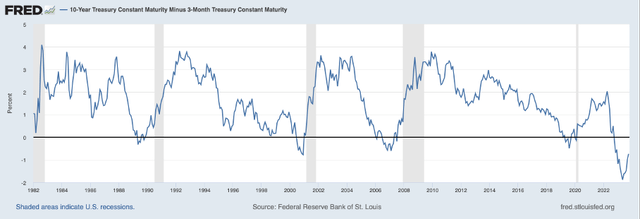
FRED
And at least since we saw the yield curve inversion in October 2022, I am quite sure a recession is upon us. Of course, that opinion is based not only on the yield curve inversion, but it is one of the more important pieces of information and the best early warning indicator. Now I am writing this article at the end of October 2023 – one year after the yield curve inversion and one might certainly ask: Where is your recession?
According to an article by Keven L. Kliesen it took on average 10 months between the yield curve inversion and the beginning of the recession and therefore we should already be in a recession. But such an argument is nonsense. First, we usually know only in hindsight if we are already in a recession and second, 12 months is the average of the last few decades. In one case it took only 5 months, and in one case it took 16 months and this time it might take 14 months or even 17 months.
Many are therefore arguing that this recession is just expected by almost everybody, but it won’t come. And the Fed also seems to be quite optimistic about a soft landing. However, when looking at this chart by VisualCapitalist we see other people not being so optimistic.
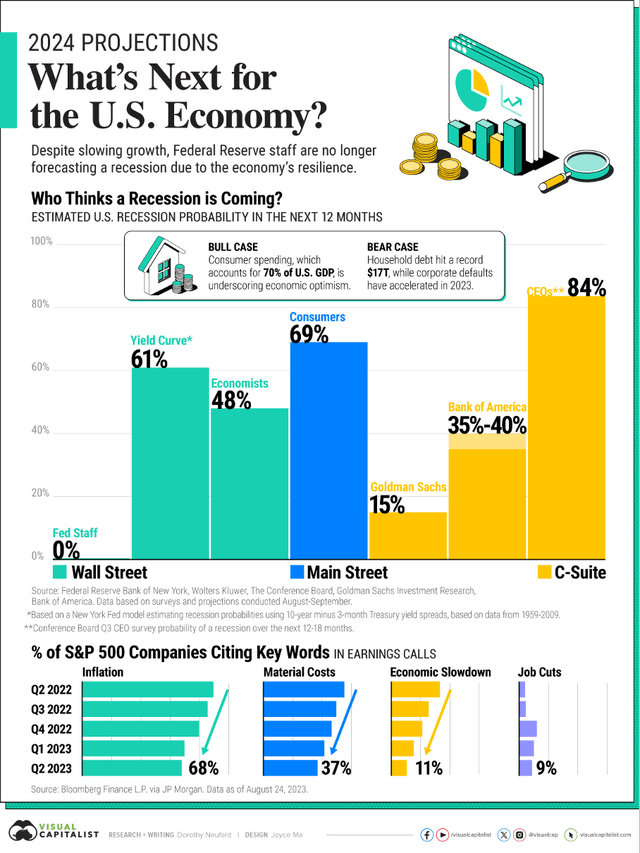
VisualCapitalist
By the way, the yield curve going back from its inverted level is also something that usually happens before a recession begins. And we are seeing the spread coming back from its extreme negative territory.
Fed Pivot
In my last article I argued that the Fed pivot will be one of the next steps. And we can’t know with certainty if the pivot actually happened before the Fed lowered rates for the first time. Right now, opinions are split and while some are seeing one more rate hike, the Fed held the federal funds rate stable in its last meeting. And during this rate hike cycle keeping the rates stable happened only once before and it could be a first sign for a pivot. However, we can’t be sure before the Fed is not actually lowering interest rates or is giving clear signs in its Minutes.
Unemployment: Initial Claims
Aside from the Fed pivot, increasing unemployment will be another step towards the recession and it will be especially visible in higher initial claims for unemployment. But so far, the initial claims for unemployment rather declined and are giving us no clear sign for a potential recession.
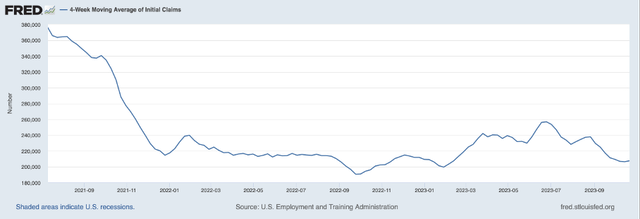
FRED
After the weekly initial claims have increased following the low of October 2022, the number declined again in the last few months. And we can try to interpret the number in different ways, but in my opinion this metric is giving us no clear sign for an upcoming recession so far.
Delinquency Rates and Bankruptcies
While we can’t be sure about a Fed pivot so far and don’t see rising initial unemployment claims, we are seeing increasing bankruptcies in the United States. When looking at the data from S&P Global, year-to-date bankruptcy filings (until August) were higher than in any other year since 2010 – with one exception: In 2020 when the United States were also in a recession.
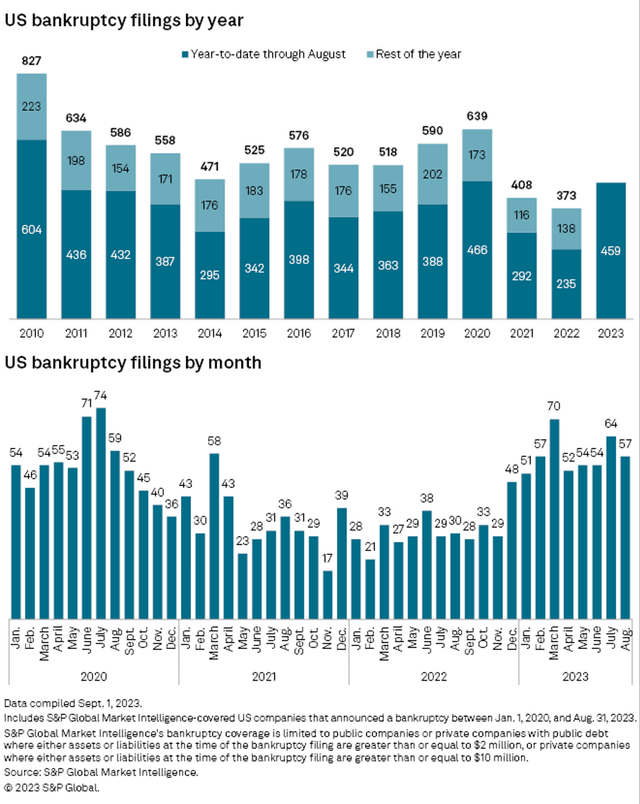
S&P Global
In the first eight months of 2023, 459 companies filed for bankruptcy in the United States. And not only bankruptcies are increasing – delinquency rates are also increasing. I would not argue that delinquency rates are a good early warning indicator as the numbers are not increasing before every recession. And when for example looking at the Great Financial Crisis, we can see the delinquency rates skyrocketing as the economy was already in a recession – not a good early warning indicator.
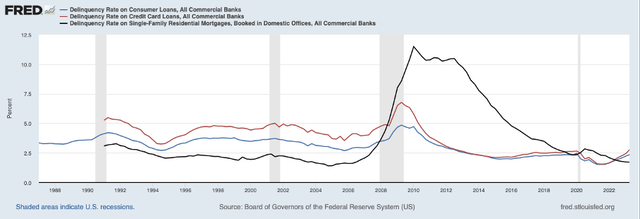
FRED
But we can clearly see delinquency rates increasing – especially for credit cards – and this is not a good sign. To put the numbers into context we also must point out that credit card delinquency rates were much higher in the past – even in times of no recession.
In my article published at the end of March, I also mentioned car delinquencies and according to data from Fitch Ratings, the subprime borrowers with more than 60 days delinquent rose to a new high – and to levels much higher than during the Great Financial Crisis.
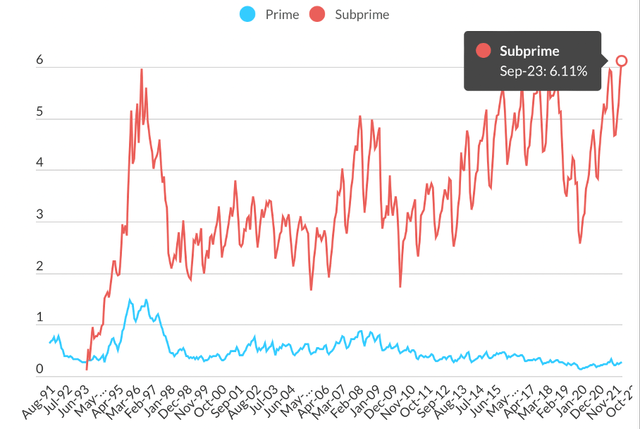
U.S. Auto Loan 60+ Delinquency Index (Fitch Ratings)
However, car loans and credit cards are almost not worth mentioning compared to mortgages – at least when talking about volume. The major category in loans that could create huge problems are mortgages – but as we can see in the chart above, mortgages delinquency rates are still at an extremely low level.
Housing Market
And when looking at some other metrics, the housing market seems to be in solid shape. Housing permits remain more or less stable since the number bottomed in January 2023. To be more precise the number was slightly increasing over the last few months, but it is nowhere close to the peak in late 2021.
And when looking at the August 2023 data from the National Association of Realtors, the newly constructed home sales are declining but the numbers are in a similar range as pre-COVID. Especially the existing-home sales are indicating trouble with sales being down 23% year-to-date.
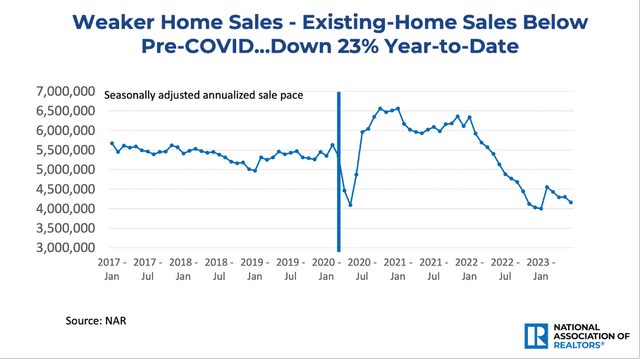
National Association of Realtors
But as we [all] have learned during or after the Great Financial Crisis (just by watching movies like The Great Short) it can sometimes take several years before problems that already seem visible are really manifesting themselves as problems with the potential to crash the economy. And when looking at the monthly payments necessary to buy an average house it is difficult to argue that everything is fine and prices (which already have declined a little bit) are at reasonable levels.
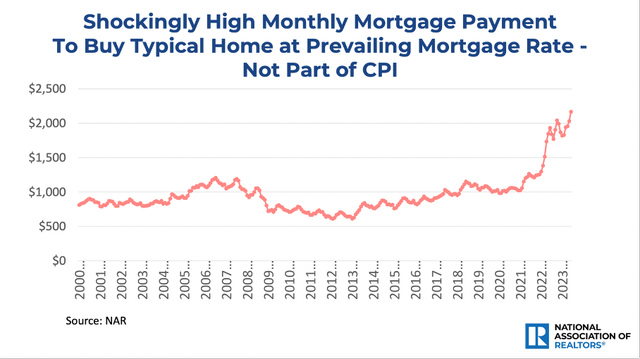
National Association of Realtors
And the housing market is closely linked to most major or regional banks, which also seem to have troubles brewing under the surface.
Regional Banks
In my article published at the end of March 2023 it was especially the regional banks that were in focus following two major bank failures. In the meantime, we are looking at four bank failures, but the fourth bank Heartland Tri-State bank only had assets of $139 million. And when looking at reports and news stories it seems like the concerns about regional banks are not an issue anymore. However, when looking at the regional bank index we are close to the March 2023 lows again and in the last few weeks, the index has been constantly declining.
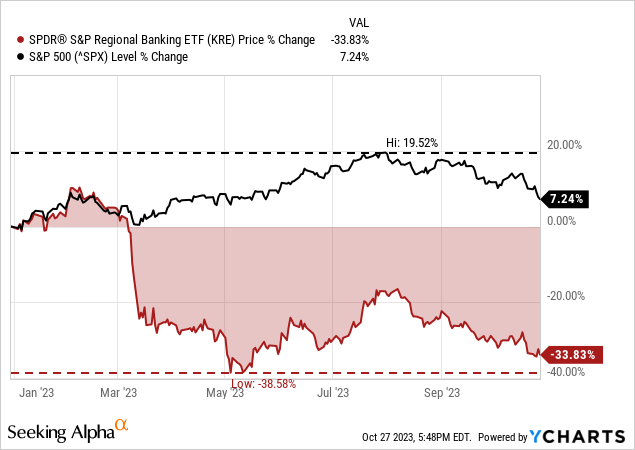 Data by YCharts
Data by YCharts
And of course, the performance of a stock or index tells us nothing about the fundamental performance – in this case the fundamental performance of regional banks. But it is showing us that investors seem to be worried again.
But as I have pointed out – once again – in my last article about the Bank of Nova Scotia (BNS), deposits for banks are declining and especially unrealized losses are at record highs (numbers we haven’t even seen during the Great Financial Crisis).
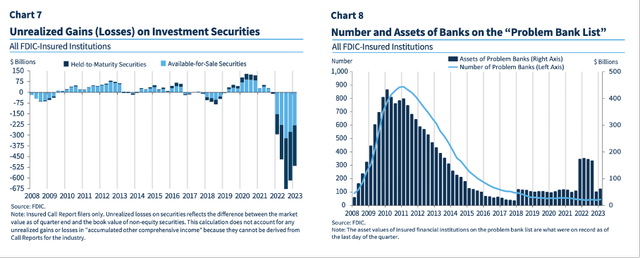
FDIC Quarterly
A Completely Different Perspective
Of course, we can also have a completely different perspective and argue very bullish. In a recent article titled Are Novo Nordisk and Ozempic saving the economy? I discussed the question if Novo Nordisk (NVO) is saving the economy based on the thought-provoking hypothesis, I got from a podcast episode. In the article I wrote:
And of course, I see the connection between people living longer and healthier and the contribution to the workforce this could have. If some people are able to work a little longer (maybe one year), this will have an impact on productivity and GDP. And this is especially important news in a time when the population is getting older and older and the population in the working age will stagnate (in other countries — especially in Europe — the picture is even worse).
But I honestly don’t think Ozempic (and other weight loss drugs) will have such a huge impact on the economy to prevent a recession.
Another Completely Different Perspective
Another perspective is provided by Avi Gilburt and technical analysis. He is frequently arguing that the stock market is not reacting to news stories but is rather driven by sentiment – and he is certainly right. In an article published about one week ago, he still made a rather bullish case – but also said depending on the stock price action he might turn bearish quickly. Avi wrote:
However, should the market see a sustained break of the 4165SPX region, and we continue down to the 4060-4100SPX region, then I have no choice but to change my primary perspective and view this decline as wave 1 of the 5-wave c-wave pointing us down to the 2900-3300SPX region as we look towards 2024.
And at the time of writing, the S&P 500 is very close to that “make or break” region outlined in the article. As I was almost ready to publish my article, Avi wrote another update titled The Bears May Get What They Want – A Market Crash and he outlined what he already indicated before:
With the breakdown below 4165SPX, and heading directly to the 4100SPX region, it tells me that the market may be setting up a market crash a bit sooner than I had expected. Do I think this is happening tomorrow? Well, not unless we see a direct breakdown below 4000. But, the great majority of the time that the market is in this posture, we normally see a sizeable rally, which can set up a market crash. And, I hope you are sitting, but if that setup develops, then my target is the 2900-3300SPX region. Believe it or not, this would only be the first leg down in a multi-year bear market.
Bottom Line
The economy may look fine on the surface with the labor market still being in great shape and inflation rates declining again. Under the surface, we see problems brewing with the rising bankruptcy filings, the rising delinquency rates as well as the huge unrealized losses of the major banks in the United States indicating trouble.
And this is on top of many other problems that have been mounting over the last decades – like the extremely high debt levels which make it much more difficult to navigate any crisis. For more details, I would like to refer you to Ray Dalio’s writing (for example on LinkedIn) and especially the book Principles for dealing with the changing world order.
I personally expect the market to crash to about 3,200 points in the next few months (after we see a small recovery before). And this is only the first target on our way down. I will quote from the conclusion of my March 2023 article:
And as I have outlined in past articles (see here and here), I see the S&P 500 going to most likely 1,600 points over the next few years - of course it could bottom even lower (and in a rather unlikely scenario it could find its bottom higher).
Disclaimer: Investing carries risk. This is not financial advice. The above content should not be regarded as an offer, recommendation, or solicitation on acquiring or disposing of any financial products, any associated discussions, comments, or posts by author or other users should not be considered as such either. It is solely for general information purpose only, which does not consider your own investment objectives, financial situations or needs. TTM assumes no responsibility or warranty for the accuracy and completeness of the information, investors should do their own research and may seek professional advice before investing.

